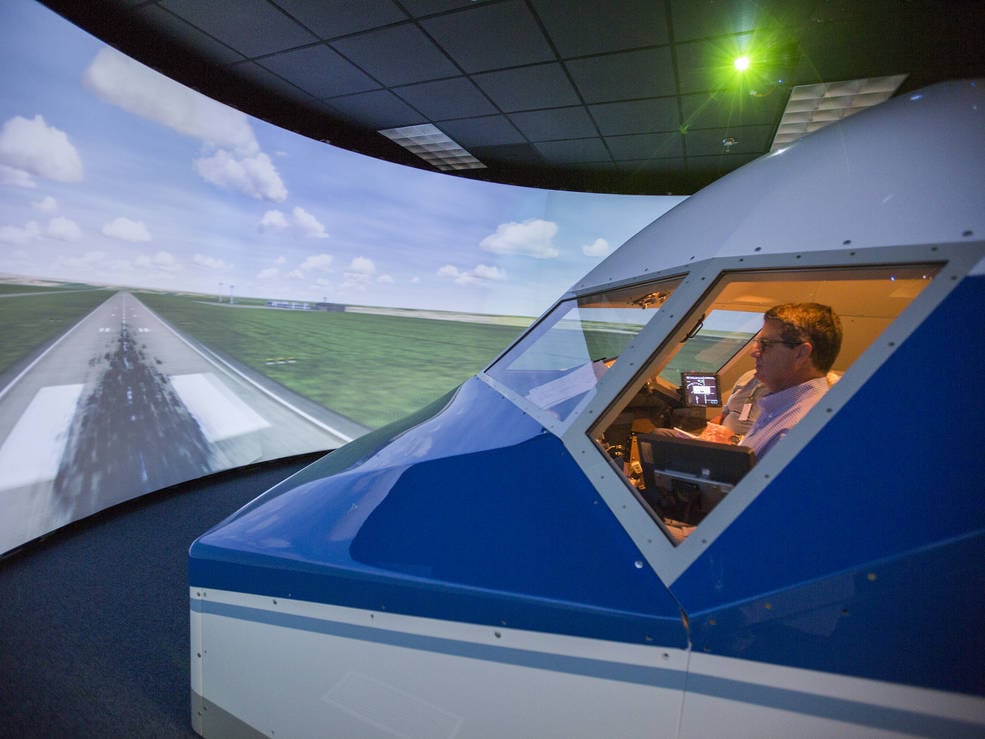[Avionics Magazine 11-08-2016] A coordinated effort involving NASA, the Federal Aviation Administration (FAA), and the aviation industry to develop and evaluate new technologies and procedures related to aircraft scheduling and airport arrivals will get a major test in 2017, according to a new announcement from NASA. It’s called Flight Deck Interval Management (FIM) and it promises to safely increase the number of airplanes that can land on the same runway at busy airports by more precisely managing the time, or interval, between each aircraft arrival.

At NASA’s Langley Research Center, retired airline pilots test procedures that will be used during upcoming flight tests of a new aircraft spacing tool. The simulator is set up like a 757 jet, similar to one of the aircraft in the ATD-1 flight tests. Photo: NASA Langley / David C. Bowman.
FIM is part of NASA’s Air Traffic Management Technology Demonstration-1 (ATD-1) project. A complex field demonstration of FIM involving NASA, the FAA and industry will be conducted in early 2017 over Seattle, Washington.
Current air traffic control technology and procedures can predict arrival times to within a minute or so. But FIM is expected to enable controllers and the airport to count on aircraft arriving within five to 10 seconds of a predicted time.
The cockpit-based prototype FIM system combines NASA-developed software with commercially available off-the-shelf hardware and connects the system to the aircraft’s onboard information and navigation systems.
Here’s how FIM is to work:
• Relying on their experience and existing tools — some previously developed by NASA and turned over to the FAA for deployment — air traffic controllers determine the ideal goal for spacing aircraft as they approach the airport.
• A controller then contacts the pilots of a particular aircraft, informing them of the spacing goal, the trajectory the aircraft should fly, and the ID of an aircraft ahead of them. This is where the idea of playing “follow the leader” comes into the picture.
• The pilots then enter all of this information into the FIM system, which then computes a solution with the additional help of input from the airplane’s Automatic Dependent Surveillance-Broadcast (ADS-B) unit.
• The result is a number displayed on FIM screens for the pilots to see that tells them what speed to fly so they can follow the specified aircraft a safe distance in front of them all the way down to the runway.
At the heart of FIM is NASA’s Airborne Spacing for Terminal Arrival Routes (ASTAR) software, which was successfully demonstrated in 2014 flying aboard Boeing’s ecoDemonstrator 787 aircraft. During those “proof of concept” flight tests, a NASA engineer located in the main cabin of the airplane, who then radioed the speed commands to the pilots up in the cockpit, operated ASTAR on a laptop.
For ATD-1 in 2017, ASTAR will be loaded into commercially available hardware, which is essentially flight hardened and certified personal tablets that will be installed on the flight deck in plain view of the pilots.
The field demonstration will take place over Seattle and encompass a fully coordinated effort involving NASA, FAA facilities, and three different aircraft: a Falcon 900 jet and Boeing 757 supplied by Honeywell, and a Boeing 737 provided by United Airlines. The Honeywell 757 and United 737 will be equipped with the FIM system in its cockpits, where its pilots will “follow the leader” behind the Falcon.